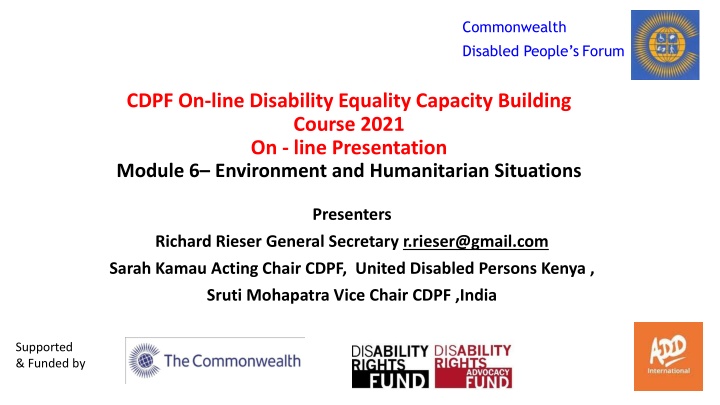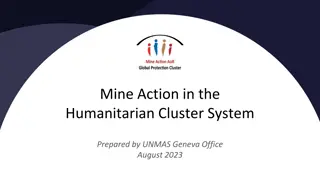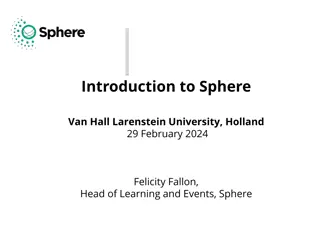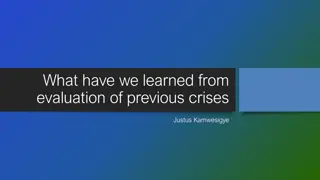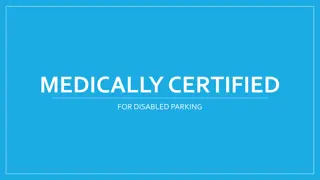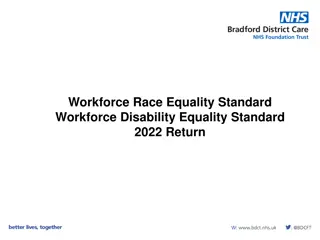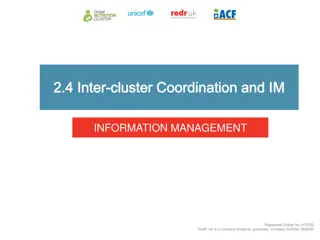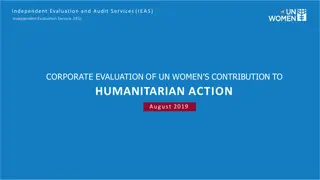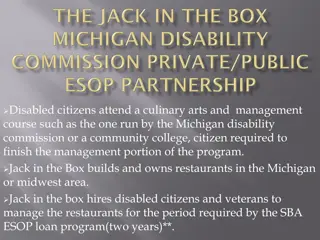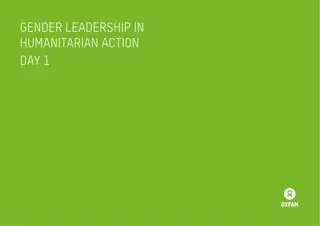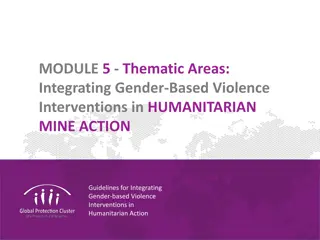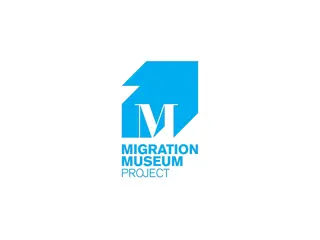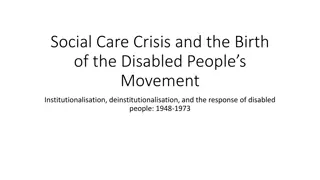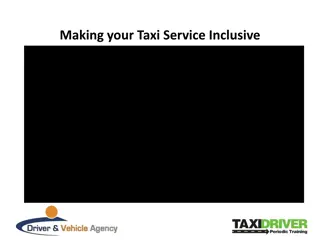Commonwealth Disabled People's Forum 2021: Environment and Humanitarian Situations
In the on-line Disability Equality Capacity Building Course presented by the Commonwealth Disabled People's Forum, module 6 focuses on Environment and Humanitarian Situations. The presenters explore the critical link between climate change, humanitarian crises, and the impact on disabled individuals. Insights are shared on addressing challenges and advocating for the rights and support needed in these complex scenarios. Join the discussion on key findings, strategies, and actions required to create a more inclusive and resilient environment for all.
Download Presentation

Please find below an Image/Link to download the presentation.
The content on the website is provided AS IS for your information and personal use only. It may not be sold, licensed, or shared on other websites without obtaining consent from the author.If you encounter any issues during the download, it is possible that the publisher has removed the file from their server.
You are allowed to download the files provided on this website for personal or commercial use, subject to the condition that they are used lawfully. All files are the property of their respective owners.
The content on the website is provided AS IS for your information and personal use only. It may not be sold, licensed, or shared on other websites without obtaining consent from the author.
E N D
Presentation Transcript
Commonwealth Disabled People sForum CDPF On-line Disability Equality Capacity Building Course 2021 On - line Presentation Module 6 Environment and Humanitarian Situations Presenters Richard Rieser General Secretary r.rieser@gmail.com Sarah Kamau Acting Chair CDPF, United Disabled Persons Kenya , Sruti Mohapatra Vice Chair CDPF ,India Supported & Funded by
Introduction Introduction UN climate report a red alert for the planet: Guterres 2021 is a make or break year to confront the global climate emergency. The science is clear, to limit global temperature rise to 1.5C, we must cut global emissions by 45% by 2030 from 2010 levels. Today s interim report from the UNFCCC is a red alert for our planet. It shows governments are nowhere close to the level of ambition needed to limit climate change to 1.5 degrees and meet the goals of the Paris Agreement. The major emitters must step up with much more ambitious emissions reductions targets for 2030 in their Nationally Determined Contributions well before the November UN Climate Conference in Glasgow, said UN Secretary-General Ant nio Guterres. 26th February 2021
Introduction Learn from Covid 19 Response Introduction Learn from Covid 19 Response There is little doubt that Covid 19 and other ongoing virus pandemics are being also caused by a cross over between humans, domestic and wild animals, as humans encroach more and more on wild habitats. Our ability to survive as human beings is in the balance and unless all people talk to each other through their Governments and these Governments collaborate on an ongoing basis we only face more human and catastrophes. As disabled people, we learned during the Covid Pandemic our hard-won Human Rights can be dashed, as we are triaged out of scarce ventilators and don not receive the supports we need to live. We can safeguard our rights and get the humanitarian assistance we are owed by Governments implementing Article 11 of the UNCRPD. This can only be done by getting all our countries, the Commonwealth and UN to take our Human Rights seriously, as part of greater efforts to implement the Sustainable Development Goals, develop climate justice and support peoples everywhere to live more in harmony with the limited and interconnecting life support system that is Planet Earth.
The language the CDPF uses The language the CDPF uses Disabled people: Why we still choose to call ourselves disabled people . In the Commonwealth Disabled People s Forum (CDPF) we call ourselves disabled people because of the development of the social model of disability . In the C19th and C20th, a disabled person s medical condition was thought to be the root cause of their exclusion from society, an approach now referred to as the medical or individual model of disability. We use the social model of disability , where the barriers of environment, attitude and organisation are what disable people with impairments and lead to prejudice and discrimination. So to call ourselves persons with disabilities is to accept that we are objects and powerless.We also view ourselves as united by a common oppression so are proud to identify as disabled people rather than people with disabilities . When we are talking about the UN Convention on the Rights of Persons with Disabilities we will use people or persons with disabilities .
What we aim to cover What we aim to cover 1. The growing environmental crisis 2. Impact on Disabled People 3. Example of Kiribati- What must be done? 4. Humanitarian Situations and disabled people 5. Armed Conflict/War 6. Accidents 7. Natural disasters 8. Examples of Good Practice
Greta Thunberg and George Monbiot : This is not a drill
For Disabled People to Live Healthy Independent lives what do we need? Medical - quality healthcare, equipment, supplies, medicines Life quality resources - personnel assistance, accessible housing, transportation Funding and stability Social Services, benefits/ employment, community, family support These things take time to develop among at risk populations such as disabled people Change which is definitely coming from climate change and environmental crisis requires we start planning for these events now.
Impacts of Eco Impacts of Eco- -Crisis on Everyone Crisis on Everyone Floods, Droughts, Fires, Heat waves! Floods, Droughts, Fires, Heat waves! Direct Impacts Indirect Impacts Stronger and more frequent Storms Infrastructure change Expanding Droughts and Forest Fires Food Insecurity Sea Level Rises and Acidification Poor Health and mentality More Intensive Heat waves Economic disruption General weather patterns change Environment/Ecosystem instability Habitat Loss Widespread migration-climate refugees- 200 million to 1 billion by 2050
Impact of Disability Impact of Disability Non Disabled People Disabled People Greater Prevalence Impairment Inaccessible shelter/evacuation-transport Storm related injuries Fragile support systems-medical/PAs Crop Shortages- malnutrition/stunting Recovery Finance Invasive diseases-Malaria Head Exhaustion/Heatstroke Increased War and Armed Conflict Air Quality-Respiratory/heart attack Poorer Poorer
Key Issues Planning Ahead Key Issues Planning Ahead Involve DPOs in every stage of planning Try ant mitigate by cutting emissions DPO have Solidarity with Climate Campaigners Plan disaster relief and recovery is accessible and takes on our needs. Accessible shelters an d transit Food ad economic security Benefits and healthcare and social pare support sufficient Communications accessible Employment/Benefit security Local support is available and can set up Independent Living Centres
Kiribatia low-lying, resource-poor Pacific atoll nationis one of the most at risk countries in the World to the impacts of climate change, including the likely detrimental effects on disabled people
Kiribati National Disability Policy And Action Plan 2018 2021 involved Te Toa Matoa-1 1. Develop a guide to assist all GoK ministries to include people with disabilities in all services, programs and plans. 2. Maintain a register of prioritised GoK strategic and operational policies to be reviewed against CRPD. 3. Review the Kiribati Joint Implementation Plan (KJIP) for climate change and disaster risk management to assess its inclusiveness of people with disabilities 4. Develop Standard Operating Procedures to address the needs of A Guide for Inclusion is developed for the GoK. TTM and other stakeholders are consulted about the priority GoK strategic and operational policies to be reviewed against CRPD.
Kiribati National Disability Policy And Action Plan 2018 2021 involved Te Toa Matoa-2 An Implementation Plan with timeline is being used to manage and monitor the review of strategic and operational policies. Churches and Faith Based Organisations are actively contributing to the actions outlined in the NDP. KiLGA Strategic Plan is developed and people with disabilities are included in all planning processes. The needs of people with disabilities are included in island council strategic plans and budgets. a) conduct a workshop with people with disabilities and sports stakeholders to identify how to ensure access and inclusion b) include people with disabilities in sport, recreation and leisure activities in the community c) conduct access audits on sporting facilities and seek resources to modify facilities to ensure accessibility d) increase opportunities for people with disabilities to compete at elite levels.
Armed Conflict, Armed Conflict, War and Disabled People War and Disabled People During conflicts, many challenges arise for all civilians affected. These challenges are heightened for disabled people, as institutional, attitudinal, and environmental barriers and risk factors are exacerbated in crisis or conflict situations. PTSD and psychological trauma are usually massively under-estimated The disability of war casualties depends on the nature of their impairment, the quality of medical treatment, the rehabilitation they receive and how effectively the barriers they face are overcome and compensated. More than 240 regional and civil wars that have occurred since the ending of World War II, millions have developed life-long impairments. Chemicals such as Agent Orange have had long term negative health impacts on both troops and civilians in Vietnam Land mines left in the ground impact largely on children playing and women gathering wood or farming. Since the Land Mine Ban Treaty in 1999 (now adopted by 160 countries ) the number of people killed or injured by mines each year has fallen dramatically Over the last 100 years, rape and sexual abuse of women and children has moved from being seen as part of the spoils of war and is now a gendered war weapon.
Imperial Powers used people in War 1.4million soldiers from Greater India 47,746 dead 65,126 wounded 500,000 Africa 71,000 dead 100,000 wounded
888,246 British Military Dead Each Ceramic Poppy for a British Service Person Killed in 1st WW What about the 2,400,000 who came back as disabled people? Was it a Land Fit for Heroes ?
Accidents and disability Accidents and disability On the night of December 2-3, 1984, approximately 40 tons of the toxic gas methylisocyanate (MIC) spewed from a factory owned by the U.S. chemical giant Union Carbide Corporation (UCC), in Bhopal, a city in the heartland of India. Blown by the wind, the gas covered an area of some 40 square kilometers. The entire population of old Bhopal was affected, pregnant women miscarried as they ran, children died in their parents' arms. The hospitals were overwhelmed by the dead and dying for days after. "That night" ultimately ended, but years of death and suffering had just begun.
UNCRPD Article 11 Situations of risk and humanitarian emergencies States Parties shall take, in accordance with their obligations under international law, including international humanitarian law and international human rights law, all necessary measures to ensure the protection and safety of persons with disabilities in situations of risk, including situations of armed conflict, humanitarian emergencies and the occurrence of natural disasters .
Daily Problems of Accessibility It has a direct physical impact with loss of mobility, damaged and/or loss of assistive devices (wheelchair etc.) and increased dependency, loss of comfort and a disruption in daily routine. In crisis situations, based on the latest statistics, 80% of adults on the autism spectrum are dependent on some form of public transport and when disaster strikes, this may lead to the disruption in daily routine and eventually the loss of "independence". The challenges mentioned will occur in some form of disorientation, the struggle with planning, organization and crisis management. Example. During the Hudhud cyclone in Vishakhapatnam in India, in 2014, Sai Padma, founder of Global-Aid and a wheelchair user, was stuck in her house for 20 days because a tree fell at the entrance and her wheelchair could not move until the tree was removed.
Physical Risk: Lack of access to medical treatment, and secondary health issues like fever, infections and high rate of abuse during crises including - physical, psychological, food, water, and other forms, including sexual. Example. During Cyclone Vardah in Chennai in India, a 20-year old was on a ventilator and the power shutdown because of the cyclone meant that she quickly needed to arrange an alternative. It took several hours for her life to be saved. Inclusion of Disability in Disaster Management By Ashok Hans & Nizni Hans. https://www.smrcorissa.org/upload_file/1156054884-1459324014_1459324014- inclusion-of-disability-in-disaster.pdf
Psychological Issues: a) Aggravation of depression; diminished and/or loss of self-confidence. Emotional vulnerability, general frustration, self-doubt, depression. The psychological challenges mentioned can be associated with a physical cause and effect response such as self-harm or stimming. Example. In Thailand, the rapid mental health needs assessment after tsunami, 2004 was done by researchers as a part of public health emergency response. The report revealed that while symptoms of PTSD were found among 12% of displaced and 7% of non-displaced persons, anxiety symptoms were found among 37% of displaced, and depression was reported by 30% of displaced survivors.
Acquiring new, secondary conditions: a) Psychological problems, or ulcers, pressure sores, contractures, or reduced hearing/vision. When overstimulated, sensory stimulus that is received from the different senses can lead to the fight/flight response. The key term here is sensory or auditory blindness where visual and auditory sensory stimulus is restricted and can therefore effect the outcome and reaction. Example. In Bhubaneswar, a study conducted on 323 households with disabled children showed 82 children who were improving in gait training or sitting balance had developed curvatures, undergone muscle weakness and lost sitting balance due to lack of therapy in lockdown period.
Livelihood Issues: Livelihood Issues: Destruction of existing livelihood resources, disruption of markets and problems with Government Disability Allowance. Example. According to Salma Mahbub, General Secretary, Bangladesh Society for the Change and Advocacy Nexus - June was a particularly difficult month for disabled people. The survival packages, financial assistance, and sanitisation support undertaken were not reaching them properly. Again, in many places, the ones who did not have the disability cards were excluded from any sort of support. We are expecting a second-wave of COVID-19, but till now no protection measures exist for those who have lost their jobs.
Lack of Access to Services Main barriers that impede access to services: No information on what type of service existed No knowledge of where to access services The service was too far from temporary/home locations Couldn t afford to get there Special services didn t exist Special service was too expensive Special service was not physically accessible There were no trained staff to support The staff couldn t understand needs The lack of empathy from service providers The lack of expert advice and prior knowledge of support staff - - - - - - - - - - -
Extreme Weather Disabled People and Recovery
Advance Preparation for a Disaster - Key points for disaster planning for disabled people include 1. Equal access to shelter facilities 2. Equal access to evacuation/ transportation 3. Equal access to disaster clean-up 4. Accessible shelters i. physical access ii. accessible communication and communication in alternative languages and formats iii.accessible paths iv.accessible toilets (at least one) v. accessible sleeping equipment (bed) vi.access to food and healthcare needs vii.assistive devices storage/parking space viii.facilities for power for people who need to recharge power devices. Example. After Cyclone Sidr in Bangladesh in 2007, a number of cyclone shelters were built using foreign aid. Despite information on the importance and how-to of accessible design, the shelters were not constructed to be accessible. As a study stated, not a single one of them have ramps or any other accessibility features. Even the stairs are high and risky.
Lessons Learned from Case Studies Inclusive disaster risk reduction (DRR) and preparedness. Disabled People and DPOs can have a critical role to play in DRR and preparedness, .Collecting and using disability disaggregated data for assessments and programming Relevant Participation of disabled people and their representative organizations in humanitarian response and recovery. 4. Removing barriers to access humanitarian assistance and protection. Disabled People are the most effective and strongest advocates to call for the elimination of barriers to their access to services. 5. Influencing coordination mechanisms and resource mobilization to be inclusive. Advocating for an inclusive humanitarian response for disabled people in a specific crisis can have positive outcomes.. CBM (2019) CASE STUDIES COLLECTION 2019 Inclusion of persons with disabilities in humanitarian action39 examples of field practices, and learnings from 20 countries, for all phases of humanitarian response https://reliefweb.int/report/world/inclusion-persons-disabilities-humanitarian-action-39-examples-field-practices-and
